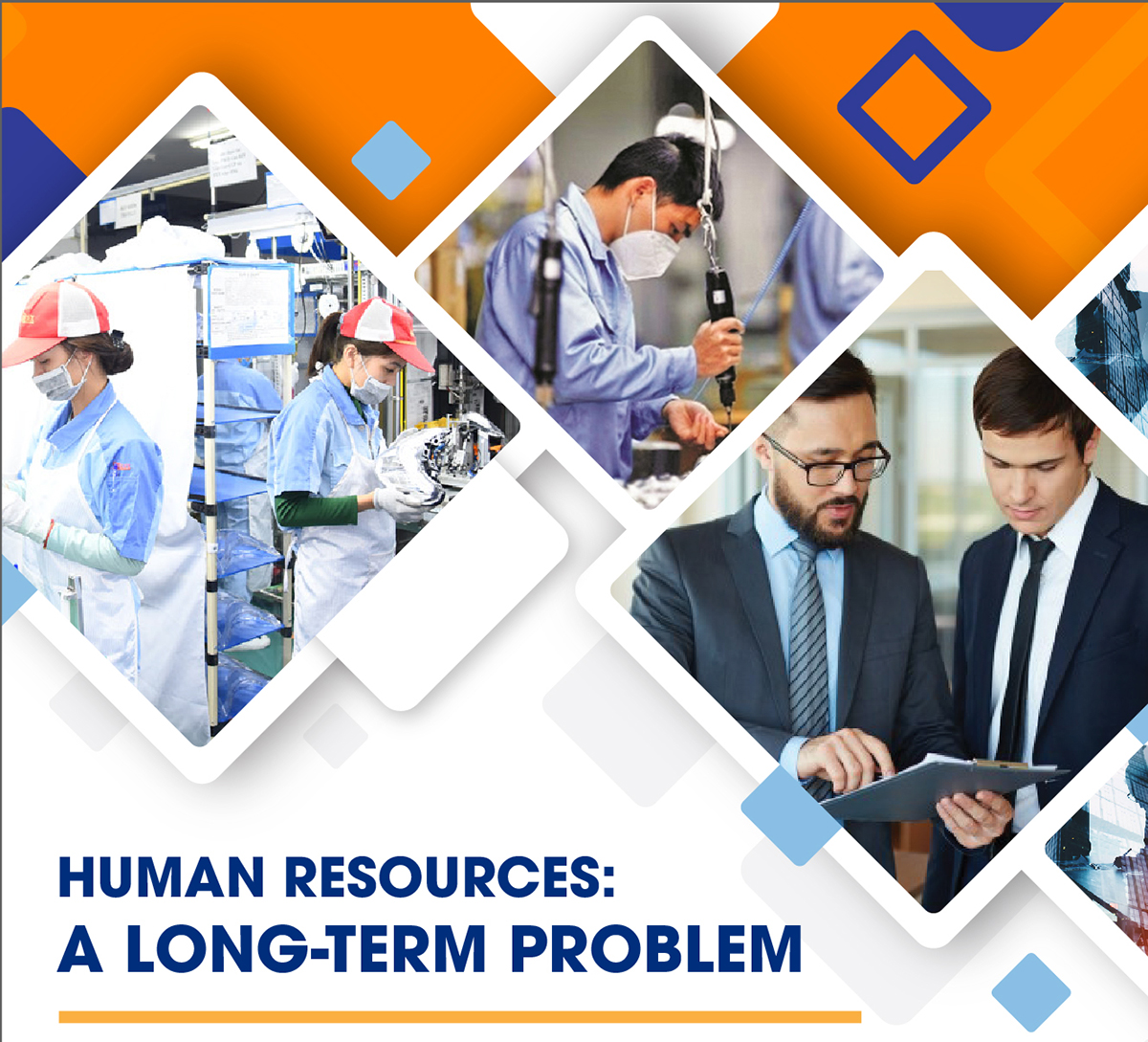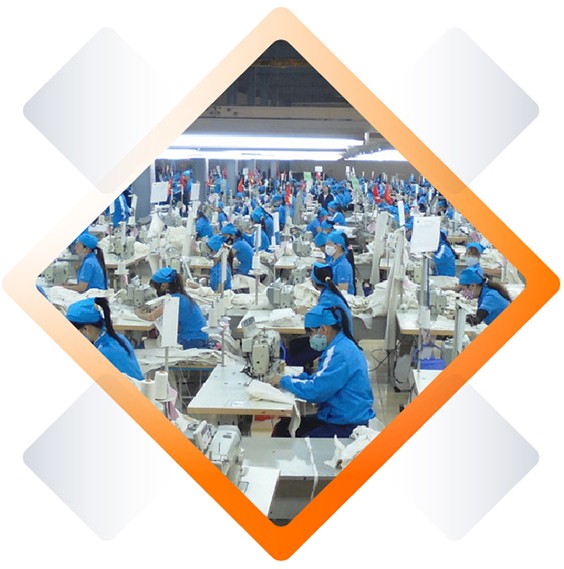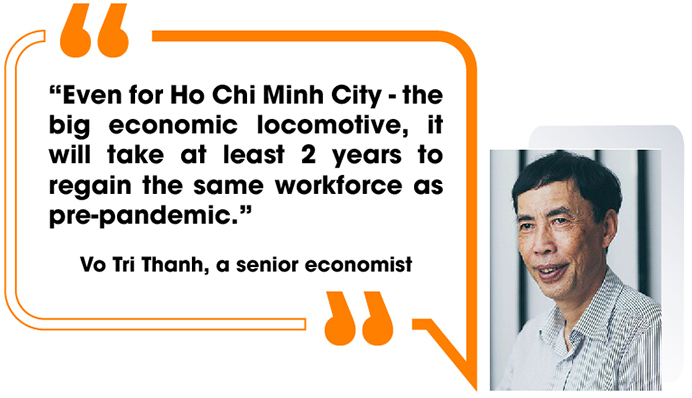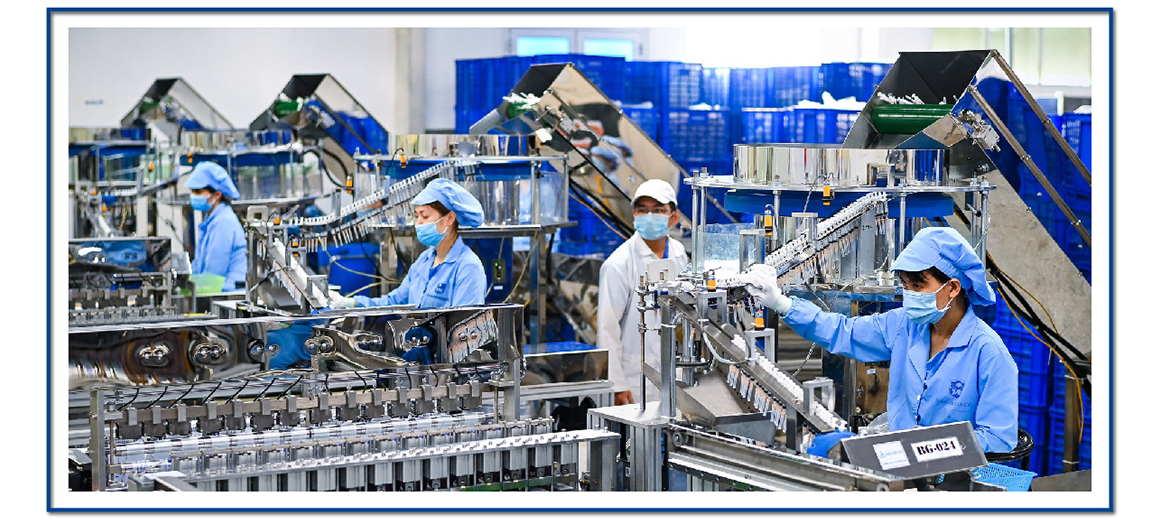
Despite a “new normal” state being established after the Government’s regulations on nationwide pandemic prevention and control, it is not easy for businesses to resume the previous production rhythm. One of the main reasons is the labor shortage.

Even though the export turnover of Vietnam’s textile and garment industry in 9 months still reached USD 29 billion, up 13.2%, Mr. Vu Duc Giang, Chairman of the Textile and Apparel Association was still worried. “It looks good to look at the number, but in reality, we are placed in a tragic situation,” said Mr. Giang
According to a representative of the Vietnam Textile and Apparel Association, the textile and garment supply chain has gone through 3 stages over the past 2 years. In the first stage when the pandemic broke out in China, the supply of raw materials was disrupted. When the outbreak moved to Europe and the US, it was a disruption in orders. It’s now production disruption due to a labor shortage.

Not only textile enterprises that rely on labor but most businesses, especially in localities that have just gone through a long social distancing period, are also getting into this situation. The shortage of labor is also a problem even in provinces/ cities where the pandemic is being controlled effectively. The recent wave of workers leaving Hanoi and Ho Chi Minh City indicates how great the pressure of labor shortage is for businesses to maintain stable production activities in the context of the new normal.

Unlike the usual labor shortage issue after each Tet holiday, the labor shortage is now significantly more serious. Many workers have decided to return to their hometowns post-pandemic. Many of them will probably not return to the factories but seek other livelihoods. The trend of labor migration may not keep the same as before.
That is also one of the reasons that Vo Tri Thanh, a senior economist said that labor is a “big deal” for both the immediate and long-term given that the Government is trying to recover the economy post-pandemic.
Data from the General Statistics Office of Vietnam shows that the working-age labor force in the third quarter of 2021 was estimated at 43.2 million people, down 1.9 million people compared to the second quarter of 2021 and down 3 million people over the same period in 2020. Unemployment and underemployment rates of the working-age population increased to the highest since the first quarter of 2020, at 2.91%

According to Mr. Doan Thanh Trung, Vice Chairman of the Ho Chi Minh City Confederation of Labor, the labor shortage used to account for 20-30% after the Tet holidays. However, the labor shortage now becomes more severe, at about 30-40%.

According to experts and businesses, soon, there must be both short-term and long-term policies, such as vaccination, solutions for workers’ safety, and support for accommodation. On the other hand, localities need to coordinate to facilitate people to travel to work.

The Government promulgates Resolution No. 128/NQ-CP promulgating the interim regulation on “Safe and flexible adaptation and effective control over the Covid-19 pandemic” and the Ministry of Health has also issued guidance on assessment criteria for Covid-19 risk level nationwide, both of which facilitate people’s travel. However, speeding up the vaccination schedule for employees is still the most consistent solution of enterprises so far.
Concerning how Samsung Vietnam overcame the pandemic, Mr. Choi Joo Ho, General Director of Samsung Vietnam said that the company has complied with all of the Government’s Covid-19 control and prevention measures.
“All of our employees have strictly followed 5K rules and social distancing regulations. We have also facilitated employees to work safely in the factory, such as providing KF94 masks and periodically testing for Covid-19. To minimize employees’ contact with the outside and ensure their health, the company has provided 3 free meals a day in the company’s cafeteria.”

Mr. Choi Joo Ho,
General Director of Samsung Vietnam
He added that the company has proactively discussed and coordinated with the Government and local authorities, regularly reported on difficulties and obstacles in the business operation. Thanks to the Government’s support to ensure production without interruption, Samsung was able to resume production, and currently, maintain stable and uninterrupted production even during the peak period of the pandemic. In 9 months, Samsung Vietnam’s export turnover still reached USD 47 billion, up 15% over the same period. The figure is expected to reach USD 61 billion for the whole year. Thanks to that, given difficulties due to Covid-19, Samsung still ensures that no employees have to quit and pay full wages to them.
 Meanwhile, according to Ms. Ho Uyen, External Affairs Director of Intel Vietnam, amidst the complicated pandemic, Intel’s top priority is to ensure the safety of workers and people, maintain production activities and contribute to the development of the economy.
Meanwhile, according to Ms. Ho Uyen, External Affairs Director of Intel Vietnam, amidst the complicated pandemic, Intel’s top priority is to ensure the safety of workers and people, maintain production activities and contribute to the development of the economy.
 “Apart from controlling workers at the factory, we also always have a provisional plan for F0 cases who will be allocated a separate area for isolation. We have also signed contracts with hospitals to arrange treatment when needed”, also stated Mr. Nozaki Shuchi, Juki Vietnam’s President.
“Apart from controlling workers at the factory, we also always have a provisional plan for F0 cases who will be allocated a separate area for isolation. We have also signed contracts with hospitals to arrange treatment when needed”, also stated Mr. Nozaki Shuchi, Juki Vietnam’s President.
Enterprises have started to apply the 4-on-site model (eat, stay, work, and medical care at the workplace) to ensure smooth production without interruption even in case of F0 cases in the factory and create trust and peace of mind for workers during work at the same time.

In addition, in the face of a shortage of labor force, many enterprises have established a favorable salary and remuneration regime and working conditions to attract new employees in parallel with bringing the current employees back to urgently complete domestic and foreign orders for the year-end.

Apart from dealing with current urgent problems, strategic and long-term solutions are key to solving the labor problem – the “big” problem of the economy post-pandemic by nature.

In a recent discussion, the National Assembly’s Social Committee asked the Government to study and develop a comprehensive and long-term socio-economic strategy, especially on labor, employment, health care, and social support to adapt to the development of the Covid-19, restore the economy, and labor relations that have been broken or interrupted due to social distancing. In particular, it is necessary to focus on setting new labor standards and working relation regulations in line with the development of the Covid-19.
When developing the Draft Economic Development and Recovery Plan for the period of 2022-2023, it is clear that the focus is not only on the problem of labor shortage but also on how to improve the quality of labor in the new normal. The Ministry of Planning and Investment has also proposed a set of overall solutions to this problem.
According to Deputy Minister of Planning and Investment – Mr. Tran Quoc Phuong, developing the labor market and labor force is a key solution for economic recovery.

This proposal immediately received consensus from both domestic and foreign economic experts. “To recover the economy, it is necessary to have radical solutions to retain workers, bring them back, restructure and train workers, and enhance the quality of human resources at the same time”, said Mr. Vo Tri Thanh.
Meanwhile, experts from the world’s leading consulting firm BCG (Boston Consulting Group) also said that for Vietnam’s economy to continue to grow post-pandemic, it is necessary to accelerate the national digital transformation program. Currently, many countries around the world have also chosen this path to take advantage of post-pandemic development opportunities.

Even in the absence of the pressure of labor shortage post-pandemic, improving the quality of human resources and keeping up with the requirements of the industrial revolution 4.0 is still vital to the Vietnamese economy.
Vietnam has recently attracted a series of technology giants to “nest”, such as Samsung, LG, Foxconn, Luxshare, Pegatron, etc. However, the lack of high-quality human resources is still a matter of concern to these companies.









Comment